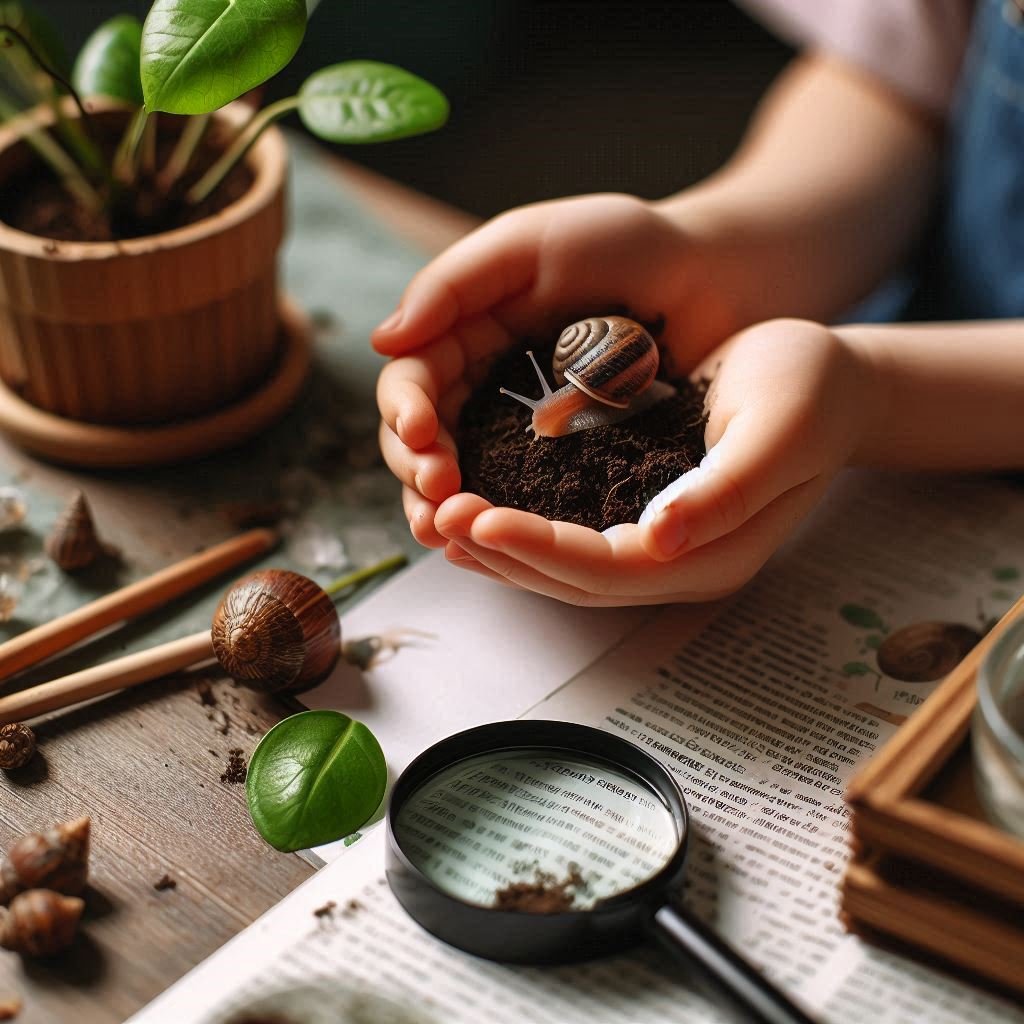If you’re looking for a low-maintenance, fascinating, and unique pet, you might want to consider getting a pet snail. These slow-moving creatures are easy to care for, quiet (no barking or meowing!), and are perfect for small living spaces. Plus, they’re great for teaching kids about responsibility and the wonders of nature. Whether you’re interested in a garden snail, a land snail, or even a more exotic species, snails make intriguing pets that will happily slime their way into your heart.
In this beginner’s guide, we’ll cover everything you need to know about how to care for a pet snail, from setting up their habitat to feeding, cleaning, and keeping them happy and healthy.
1. Choosing the Right Type of Snail
First things first—what kind of snail do you want? While snails are available in a variety of species, not all are equally suited to life as a pet. Here’s a list of some of the most common snail species kept as pets:
| Species | Size | Lifespan | Personality | Common Care Needs |
|---|---|---|---|---|
| Garden Snail | Small to Medium | 2-5 years | Easygoing, hardy | Basic, beginner-friendly |
| Giant African Land Snail | Large (up to 8 inches) | 5-10 years | Docile, easy to handle | Requires more space |
| Roman Snail | Medium | 5-10 years | Curious, slow-moving | Moderate care needs |
| Aquatic Snails | Small | 1-2 years | Active in water | Needs a water tank |
Most beginners start with garden snails, which are easy to find and require minimal care. However, if you’re up for something more exotic, Giant African Land Snails are a popular choice because of their size and gentle nature.
Important note: In some regions, keeping certain types of snails (like Giant African Land Snails) may be illegal due to their invasive nature. Always check your local laws before getting an exotic species!
2. Setting Up the Perfect Habitat
One of the great things about snails is that they don’t need a lot of space, but they do need a habitat that mimics their natural environment. You can easily set up a snail habitat with a few basic supplies.
What You’ll Need:
- Tank: A glass or plastic tank with a secure lid is perfect. For a small garden snail, a 5-10 gallon tank works well, while larger species like Giant African Land Snails will need a tank of at least 20 gallons.
- Substrate: Use natural soil (pesticide-free), coconut coir, or sphagnum moss for the tank’s base. This will help maintain humidity and give your snail a comfortable surface to burrow in.
- Humidity: Snails need a moist environment to thrive. Mist the tank daily with water to keep the humidity level high (around 75%-90% depending on the species).
- Temperature: Most pet snails prefer temperatures between 65°F and 80°F (18°C to 27°C). Keep the tank out of direct sunlight and away from cold drafts.
- Hiding Spots: Provide a few hiding places like small pots, pieces of bark, or hollow rocks. Snails like to hide during the day since they’re nocturnal creatures.
| Habitat Feature | Purpose |
|---|---|
| Substrate (soil or moss) | Provides a soft, burrowable surface |
| High humidity | Keeps snails moist, aids breathing |
| Hiding spots | Offers comfort and reduces stress |
| Tank lid | Prevents escape (snails are sneaky!) |
3. Feeding Your Pet Snail
One of the easiest parts of snail care is their diet. Snails are herbivores, which means they mostly eat fruits, vegetables, and leafy greens. However, it’s important to offer a variety of foods to ensure they get all the nutrients they need.
What to Feed:
- Leafy Greens: Lettuce, spinach, kale, and dandelion leaves are great staples.
- Fruits: Snails love fruits like apples, bananas, and strawberries, but avoid anything too acidic like citrus fruits.
- Vegetables: Cucumber, zucchini, carrots, and sweet potatoes are all great options.
- Calcium: Snails need calcium for their shells. Provide a cuttlefish bone, crushed eggshells, or calcium powder in their tank for them to nibble on.
What to Avoid:
- Citrus fruits (e.g., oranges, lemons) – Too acidic and can harm their digestive system.
- Salty or processed foods – Snails are highly sensitive to salt, and even a small amount can be deadly.
- Sharp, hard foods – Anything that could potentially injure the soft body of a snail.
Feeding Tips:
- Feed at Night: Since snails are nocturnal, it’s best to feed them in the evening. Remove any uneaten food the next morning to prevent mold and rot.
- Keep It Fresh: Always offer fresh food, and clean out any old or spoiled food daily.
4. Cleaning the Snail Tank
Snails are tidy little creatures, but you’ll still need to clean their tank regularly to keep them healthy. A dirty environment can lead to mold growth or bacterial infections, which can make your snail sick.
How to Clean the Tank:
- Spot Clean Daily: Remove leftover food and any waste you see. Snail droppings are small but easy to spot on the substrate.
- Deep Clean Weekly: Once a week, remove your snail from the tank (gently!) and place it in a temporary container with some damp tissue or soil. Remove the substrate and rinse the tank with warm water (avoid using soap or chemicals). Replace the substrate, clean any décor, and re-mist the tank.
- Don’t Over-Clean: While it’s important to keep the tank clean, avoid using harsh chemicals or soaps. Snails are sensitive to these, and even small amounts of residue can be harmful.
Pro Tip: Keep a Small Backup Tank
If your snail needs to be moved for a longer cleaning or if you’re cleaning the tank more thoroughly, have a smaller, temporary tank handy to keep your snail safe and comfortable.
5. Handling Your Snail
Snails are slow and fragile, but you can handle them carefully. They can be fascinating to observe up close, and they may even learn to associate you with feeding time!
Handling Tips:
- Wash Your Hands: Before handling your snail, wash your hands thoroughly to remove oils, dirt, and any traces of soap or chemicals.
- Be Gentle: Snails are delicate, especially their shells. Always pick them up gently by sliding your fingers under their body. Never pull them off a surface, as this can damage their soft body.
- Keep Them Moist: Snails can dry out quickly when handled. Spray your hands with water to keep them moist, and don’t handle them for long periods.
- Watch the Mucus: Snails leave a slimy trail, but that’s perfectly normal! This mucus helps them move and protects their body from rough surfaces.
6. Keeping Your Snail Healthy
Snails are generally hardy little creatures, but there are a few health issues to watch out for. Keeping their habitat clean, providing fresh food, and ensuring they have plenty of calcium for their shells will go a long way in keeping your snail healthy.
Common Snail Health Issues:
- Dehydration: If your snail appears shriveled, it may be dehydrated. Increase the humidity in the tank by misting more often.
- Shell Damage: If your snail’s shell cracks or chips, make sure to provide plenty of calcium and a soft substrate. Severe damage might require help from a veterinarian specializing in exotic pets.
- Parasites: Snails can sometimes carry parasites, especially if they were collected from the wild. Monitor your snail for unusual behavior, like inactivity or slime buildup, and consult a vet if needed.
Signs of a Healthy Snail:
- Active, especially at night
- Eating regularly
- Shell is smooth and growing
- Eyes and body are moist, not dried out
7. The Snail Life: What to Expect
Snails are surprisingly engaging pets, even if they’re not the most active or cuddly. Once you have their habitat set up and care routine down, they’ll be low-maintenance companions. Watching them slowly explore, eat, and navigate their little world can be incredibly relaxing—almost like a mini Zen garden with a shell.
They’re quiet, take up very little space, and can live several years, especially larger species. It’s like having your own little piece of nature inside your home.
Conclusion: Slow and Steady Wins the Race
Caring for a pet snail is a rewarding and unique experience. Whether you’re fascinated by their slow and steady pace or you simply enjoy the low-maintenance lifestyle, snails can make great pets. Just remember the basics: provide a cozy, humid home, feed them fresh greens, and offer plenty of calcium to keep their shells strong.
With a little love and care, your pet snail will thrive in its environment and provide you with a glimpse into the fascinating world of these amazing creatures.

